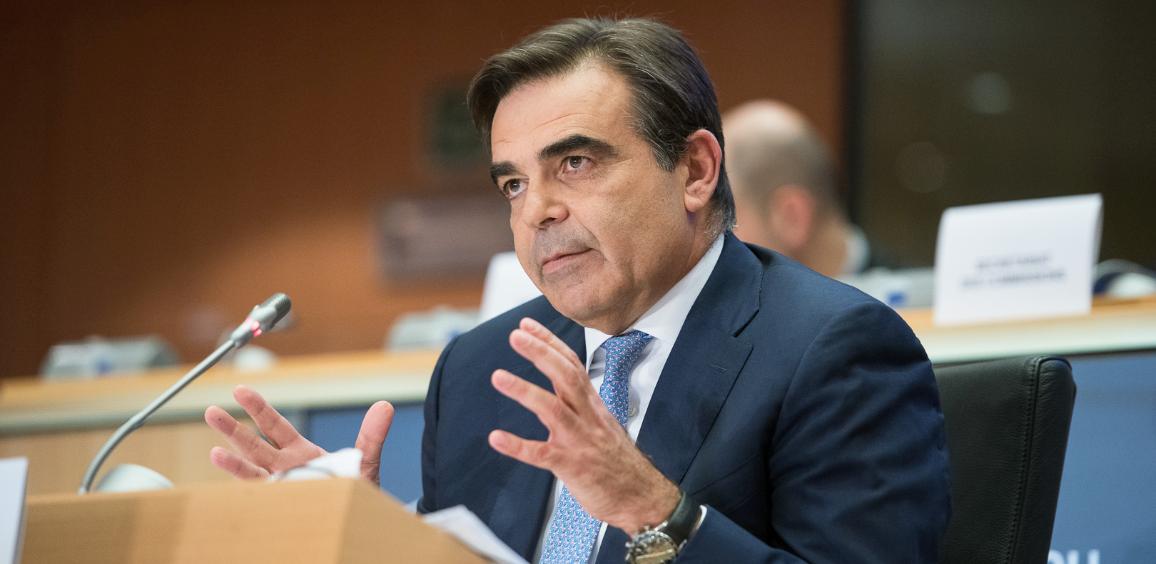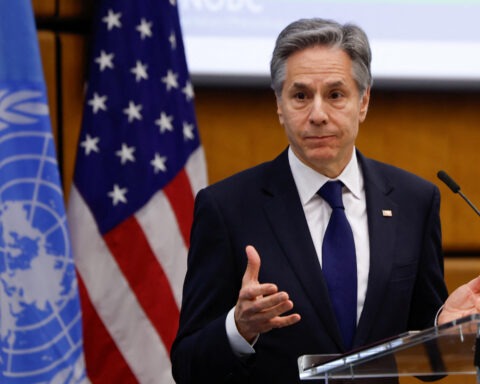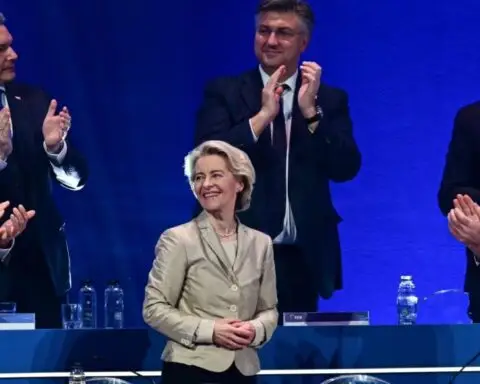This is an important moment The Pact on Migration and Asylum we are presenting today has been a long time in the making. The time for action is now. You will recall that President von der Leyen announced it at the very start of the mandate as one of the flagship initiatives of this College.
Of course, it was natural that other political priorities had to take centre stage this year (pandemic, MFF/recovery) but these proposals remain eagerly anticipated and the devastating fires in Moria this month have added a renewed sense of urgency to put this crucial topic back on top of the agenda.
Because the clock has run out on how long we can live in a house half built. The problems we see now on migration – in Moria and elsewhere – are not because of Europe but because of the lack of Europe.
The series of proposals we are presenting today is one that allows for a compromise. But we did not hatch this package ourselves in Brussels. In preparing the Pact our starting point was listening to everyone and we carried out extensive consultations to ensure that we did – doing an entire tour de capitales when this was still possible, speaking at length to the European Parliament as well as to civil society.
And you can see the results of those consultations in the texts we are putting forward today. The experiences since 2015 have exposed clearly that no one Member State experiences migration in the same way. Italy does not live migration in the same way as Greece. Nor does Germany live migration the same way as France. Nor Austria as Denmark. Each face different and unique challenges – and I would hazard to say that no one’s concerns are more legitimate than the others. They all deserve to be recognised, acknowledged and addressed.
The most important thing is that we start discussions on the Pact on a solid basis that takes everyone’s concerns into account. The wounds of 2016 are still fresh and we need to start with everyone around the table.
For us, this means it is clear we cannot present a partial package. We made this mistake in 2016, when the Commission proposals presented only half the picture: we presented a strong solidarity framework – rightly so in the wake of a humanitarian crisis – but without the corresponding responsibility elements in the form of border and screening procedures. This is the picture we are now trying to complete.
But it would be a mistake to reduce the topic of migration to a binary discussion between solidarity and responsibility, between voluntary and mandatory. It is not the case that for some to win, others must lose. That is not – and never was – what Europe is about.
Otherwise we are just doing a re-enactment of ‘Back to the Future’: the journey to the future in which you keep encountering the problems of the past. It’s time we updated the script on migration.
Migration is a multifaceted topic and it does not do anyone justice to over-simplify it.
With that in mind, allow me to outline for you the broad strokes of what must crucially be a comprehensive approach to migration.
The New Pact is like a house with three floors, comprised of:
The external dimension – centred around strengthened partnerships with countries of origin and transit
Robust management of our external borders and
Firm but fair internal rules, which ensure that solidarity is provided to Member States under pressure.
Starting from the outside in, first, the external dimension:
The new Pact represents a change of paradigm in the way we engage with our international partners on migration, recognising that this is a global phenomenon which calls for global solutions and responsibility-sharing.
Over the past years, the European Union has invested significantly in deepening its international cooperation with countries of origin, transit and destination of refugees and migrants. Since 2015, we have dedicated over 9 billion euros to supporting refugees and migrants outside the EU, providing life-saving assistance to millions of vulnerable people, supporting host communities, and fostering sustainable, development-oriented solutions. We will continue to do so.
Building economic opportunity, especially for the youth, remains a shared priority for us and our partners, and vital to address the root causes of irregular migration.
But we must recognise that in some key areas, a lot remains to be done:
Smugglers continue to profit by exploiting migrants – endangering lives and selling false hope in blatant disregard for human dignity.
Capacities for effective border management, asylum and reception systems are often lacking.
And so is a well-functioning system for return and readmission. On average every year around 370,000 applications for international protection are rejected in the EU, but only around a third of these persons are returned home. This has to change.
With the Pact, we are proposing concrete ways and tools to step up cooperation in each of these areas.
We know well that a one-size-fits-all approach won’t work. And this is why we are putting the focus on comprehensive, balanced, mutually beneficial partnerships, tailor-made to each partner country’s specific situation, interests and needs.
To support these partnerships, the EU and our Member States will systematically coordinate and bring together a wide range of policy and financing tools: from development cooperation, investment and trade, to employment, visa policy, education and research.
This will include a more strategic, flexible and policy-driven programming of the EU’s external funding, across all relevant headings under the EU budget for the next seven years. Our proposals for the Neighbourhood, Development and International Cooperation Instrument, with a total envelope of over 70 billion euros, include a 10% target for migration-related actions.
We will seek to intensify our external engagement on migration at all levels:
Bilateral, with a particular focus on key countries of origin and transit, for example in Northern Africa, the Western Balkans or Asia;
Regional, by strengthening cooperation with partners such as the African Union;
and multilateral, through more active engagement with the United Nations and its agencies, and through processes such as the post-Cotonou framework with African, Caribbean and Pacific states.
The message we send with this Pact is that for a truly sustainable approach – one that works for the EU, for our partner countries and for migrants themselves – we have to treat the external and internal dimensions of migration as inextricable. That migration is a strategic priority we are determined to pursue through our external action, in close cooperation with our partners. That we have the tools to do so, and that we will put them all to good use.
Second, we are putting the emphasis on a robust management of the external borders. Under the New Pact:
There will be a new and mandatory screening at all borders of all arrivals. Currently the only obligation is for a Member State to take the fingerprints of someone who arrived irregularly and register them. Under the New Pact, all arrivals will be subject to a thorough security, health and identity check. This will allow for immediately directing people immediately to the right procedure.
In a second stage, all those unlikely to get asylum will have to go through mandatory, fast-tracked border procedures with streamlined procedures for dealing quickly with asylum claims and efficiently processing returns.
Together this will create a seamless procedure at our external borders which ensures people are quickly channelled to and through the right procedures.
And this will be complemented by a new European ecosystem geared towards effective returns – with a new EU Coordinator on Returns and Frontex playing its full role as an operational arm for carrying out returns.
On the third floor of our theoretical house, we find firm but fair internal rules:
Any credible European migration system must be able to provide for effective solidarity in practice for those Member States who by their geography are the most confronted with migratory challenges.
Our New Pact will therefore provide for a strong solidarity mechanisms where we ensure that Member States always get the support they need.
With our migration Pact, we do not ignore the red lines, we look for a way out between them. We have done so by introducing a new concept: that of return sponsorship – and allow me to pause a second on this as it is important to explain what we mean.
This is a concept that seeks to balance out competing interests – we know that some Member States will never accept mandatory relocation. At the same time, relocation – and not sending border guards or money – is what really alleviates pressure from a Member State facing high numbers of arrivals.
So what we have sought to do is provide a viable alternative to ensure that even if they are not relocated, the same number of people are catered for. The Member State under pressure will get the reassurance that they will always be alleviated of the pressure of the same number of people – either through relocation or by people being returned directly with the support of other Member States’ diplomatic engagement or assistance to return for example. And here sponsoring Member States will be able to focus on nationalities where they see a better chance of completing returns.
At the same time, where solidarity is provided for, the system always leaves Member States with an alternative to relocation. Depending on the level of pressure and the ability of asylum systems to cope, in some cases there are many alternatives, in others, there is only one alternative (in the form of return sponsorship) but there is always this alternative.
In this way, we have struck the right balance.
This new system should be one in which such solidarity becomes the norm. The day to day of migration management in Europe in the future should be characterised by efficient procedures and effective solidarity.
That said, as much as we would like to be architects of the future we also know that we may well end up being firefighters. We have to be prepared for all scenarios. The Pact therefore includes strong crisis resilience and preparedness measures:
A new crisis blueprint brings ensures we all know who does what when and sets out the entire array of tools we can use in crisis times;
And we are adding one new tool to the box: a new crisis instrument provides a faster solidarity mechanism to react quickly in times of real crisis. And it also introduces temporary derogations and accelerated procedures to adjust to the reality of an overwhelmed system or situations of force majeure.
Let me also point out that we have taken great care throughout this entire Pact to cater for the specificity of search and rescue arrivals – which are not arrivals like any other. They are the result of the fulfilment of a legal obligation to rescue people at sea and every single one of our proposals acknowledges this – as Ylva will explain.
Lastly, a word of caution: we’re not stopping here. There are a number of elements that we will continue to prepare under the umbrella of the Pact and present proposals on in the next months. Allow me to mention two of particular importance:
Schengen – we have not forgotten this most crucial of topics. We will next year present a strategy on the future of Schengen, which will include initiatives for a stronger and more complete Schengen.
Legal migration – something we want to be very ambitious on but which deserves its own narrative, divorced from discussions on irregular migration. Which is why we have today launched a public consultation to gather views on this topic and will come with proposals next year. Legal migration is and always will be the voluntary prerogative of Member States but it is one that can be supported by an EU framework and financing.
All of the new proposals we are presenting today must be seen as a connected whole, including alongside and interconnected with the five proposals that still remain on the table. Our proposal is for a system where there is one circuit: screening, border procedure, asylum procedure, return, solidarity, everything must connect seamlessly.
Let me conclude by saying that this is a Pact in which we have learnt the lessons of the past: we have withdrawn and drawn a line under the former “Dublin” system – symbolic as it was of a system that shouldered a disproportionate burden on Member States of first entry and that was not at all equipped to deal with situations of crisis, let alone with the new reality of mixed and constant migration flows on a day to day basis.
Instead we are turning a new leaf with a new Pact on Migration and Asylum. It is designed as a much more effective and comprehensive governance system that ensures that solidarity is effective in practice and that the challenges of migration are addressed comprehensively – be it outside or inside our Union.
We have so much to be proud of in this Union. We are the largest and best regulated market in the world, we have the second strongest currency in the world, we are the champions of human rights, privacy, healthcare, education. A few months ago, EU leaders succeeded in making a huge step forward with an economic recovery fund funded by joint bonds based on the EU budget. We have everything, except a common asylum policy.
The time has come to rally around a single migration policy, befitting of the values our Union so readily embodies in every other field.
Here’s the story of a lovely lady, who was bringing up three very lovely girls. All of them had hair of gold, like their mother, the youngest one in curls. Here’s the store, of a man named Brady, who was busy with three boys of his own. They were four men, living all together, yet they were all alone. ‘Til the one day when the lady met this fellow. And they knew it was much more than a hunch, that this group would somehow form a family. That’s the way we all became the Brady Bunch, the Brady Bunch. That’s the way we all became the Brady Bunch. The Brady Bunch!
Who can turn the world on with her smile? Who can take a nothing day, and suddenly make it all seem worthwhile? Well it’s you girl, and you should know it. With each glance and every little movement you show it. Love is all around, no need to waste it. You can have a town, why don’t you take it. You’re gonna make it after all. You’re gonna make it after all.
In time of ancient gods, warlords and kings, a land in turmoil cried out for a hero. She was Xena, a mighty princess forged in the heat of battle. The power. The passion. The danger. Her courage will change the world.








